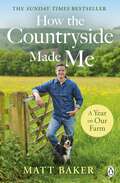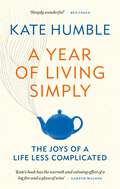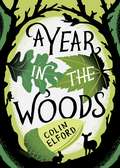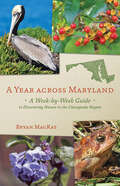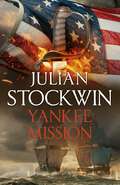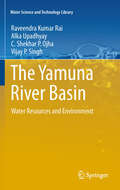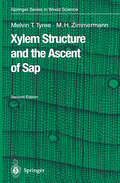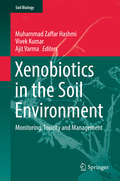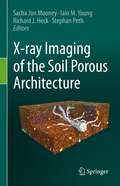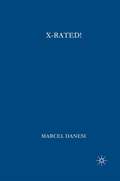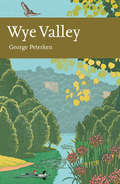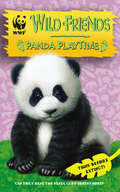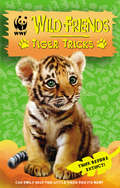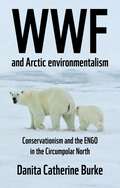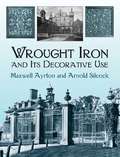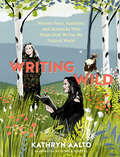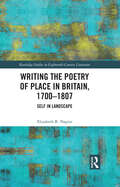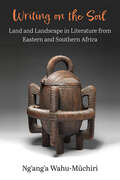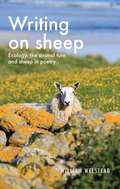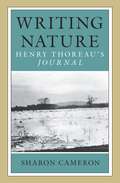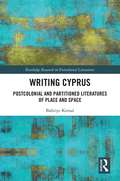- Table View
- List View
A Year on Our Farm: How the Countryside Made Me
by Matt BakerEscape into nature with Matt Baker in his first ever book - a diary of the natural year and a glimpse into family life on the farmPeppered with his hand drawn sketches and moments from his TV career throughout, this is a heartfelt and fascinating insight into Matt's life outside of our TV screens_______Matt Baker is at his happiest on the farm.Away from the bright lights of hosting our favourite television programmes, Countryfile, The One Show, Blue Peter and many more, he is often in the company of his family, dogs, array of sheep, Mediterranean miniature donkeys and a whole host of wildlife in the farm's ancient woodland.Now, following the ever-changing seasons, Matt takes us on a journey with his family on the farm.We see woodland animals emerge after a long winter of hibernation, hear the dawn chorus in the height of summer and see the preparations unfold for the harsh and wild winter months.Peppered with hand drawn sketches, unforgettable moments from his TV career and stories of a landscape you'll fall in love with, Matt offers readers a touching insight into life on the farm, and how the power and beauty of the countryside can be an inspiration and source of joy for all of us.A celebration of the natural year, Matt Baker takes us on a journey through the seasons, his life on the farm and how the power and beauty of the countryside has made him who he is.
A Year of Living Simply: The joys of a life less complicated (Kate Humble)
by Kate Humble'Simply wonderful.' - BEN FOGLE'Kate's book has the warmth and calming effect of a log fire and a glass of wine. Unknit your brow and let go. It's a treat.' - GARETH MALONE'Kate Humble pours her enviable knowledge into attainable goals. It's a winning combination and the prize - a life in balance with nature - is definitely worth claiming.' - LUCY SIEGLE'As ever, where Kate leads, I follow. She has made me reassess and reset.' - DAN SNOW'Kate Humble's new book is a lesson in moving on from a tragedy and finding our place in the world' - WOMAN & HOME'A Year of Living Simply is timely, given that the pandemic has forced most of us, in some way to simplify our lives, whether we planned to or not. Kate wrote it before any of us were aware of the upcoming crisis, but it captures the current moment perfectly... It's not necessarily a "how to" book, more of a "why not try?" approach.' - FRANCESCA BABB, MAIL ON SUNDAY YOU'What I particularly love is her philosophy for happiness, which is the subject of her new book, A Year of Living Simply. The clue is in the title. Remember the basics. Instead of barging through the day on autopilot, really stop to think about the tiniest little things that added a moment of joy. No, of course stopping and smelling the flowers won't cure all our ills and woes. But taking the time to savour the things that bring pleasure, really being in that moment and appreciating it, can remind you that most days have moments that buoy your mood.' - JO ELVIN, MAIL ON SUNDAY YOUIf there is one thing that most of us aspire to, it is, simply, to be happy. And yet attaining happiness has become, it appears, anything but simple. Having stuff - The Latest, The Newest, The Best Yet - is all too often peddled as the sure fire route to happiness. So why then, in our consumer-driven society, is depression, stress and anxiety ever more common, affecting every strata of society and every age, even, worryingly, the very young? Why is it, when we have so much, that many of us still feel we are missing something and the rush of pleasure when we buy something new turns so quickly into a feeling of emptiness, or purposelessness, or guilt?So what is the route to real, deep, long lasting happiness? Could it be that our lives have just become overly crowded, that we've lost sight of the things - the simple things - that give a sense of achievement, a feeling of joy or excitement? That make us happy. Do we need to take a step back, reprioritise? Do we need to make our lives more simple? Kate Humble's fresh and frank exploration of a stripped-back approach to life is uplifting, engaging and inspiring - and will help us all find balance and happiness every day.
A Year in the Woods: The Diary of a Forest Ranger
by Craig Taylor Colin ElfordColin Elford's A Year in the Woods is an enthralling journey into the heart of the English countryside - with a preamble by Craig Taylor.Colin Elford spends his days alone - alone but for the deer, the squirrels, the rabbits, the birds, and the many other creatures inhabiting the woods.From the crisp cold of January, through the promise of spring and the heat of summer, and then into damp autumn and the chill winds of winter, we accompany the forest-ranger as he goes about his work - stalking in the early morning darkness, putting an injured fallow buck out of its misery, watching stoats kill a hare, observing owls, and simply being a part of the outdoors.Colin Elford immerses himself in the richly diverse and unique landscapes of Britain, existing in rhythm with natural environments. For fans of Robert Macfarlane's Landmarks, Helen Macdonald's H is for Hawk orJames Rebanks' A Shepherd's Life, Colin's rare and uplifiting journey will unveil the true nature and beauty of Britain's countryside.'This is nature for real . . . Elford describes woodland wonders in short paragraphs of luminous intensity' Daily Mail'A poetic insight in the world of hidden Nature' Countryman'Stalking sharpens the senses and there is an almost hallucinatory clarity to Elford's writing' Observer'Refreshingly unsentimental. Contains some wonderful descriptions and sentences which are so profound they demand a second reading' Sunday ExpressColin Elford is a forest ranger on the Dorset/Wiltshire border. Craig Taylor is the author of Return to Akenfield and One Million Tiny Plays About Britain and the editor of the magazine Five Dials.
A Year across Maryland: A Week-by-Week Guide to Discovering Nature in the Chesapeake Region
by Bryan MacKayWhen can you find ripe blueberries along the Appalachian Trail in Maryland? Where can you see the air filled with monarch butterflies as they migrate south each autumn? If you want to enjoy nature this weekend, where is the best place to visit? Bryan MacKay can tell you.Written as an almanac, A Year across Maryland invites you to explore the natural world throughout the year, from watching bald eagles nesting in January to harvesting mistletoe in December. Entries identify the best time and place to experience such wonders as wildflowers blooming, birds in migration, amphibians singing, and morel mushrooms ready to be picked, sliced, sautéed, and devoured. Color photographs of more than seventy species enrich and illustrate the text. Every week of the year has a recommended "Trip of the Week." Personal essays that draw from MacKay's field notes provide an intimate glimpse into a biologist encounters with plants and animals over the years.Whether you want to see snow geese and trumpeter swans pausing in their northward migration each March, or the mating "jubilee" of polychaete worms during the new moon in May, A Year across Maryland offers valuable advice for the spontaneous adventurer and the serious planner alike.
Yankee Mission: Thomas Kydd 25 (Thomas Kydd #36)
by Julian Stockwin1812. Off the coast of Brazil, HMS Java, a proud British 38-gun frigate, is captured in battle by the American USS Constitution - signaling across the world's oceans a challenge to Britain's naval premiership that cannot be ignored.Back in EnglandCaptainSir Thomas Kydd is enjoying a moment of normal life with his wife and his newborn son. With his Thunderer in dock receiving some well-earned repairs he is, momentarily, without a command. It's a position the Admiralty does not leave him in for long, and he is soon given a mission: engage the young republic in a fair fight, frigate against frigate, and restore the Navy's reputation. And they have just the ship and crew for him . . . Tyger. But on reaching the US east coast, Kydd and his trusted Tygers realise that the hardest part of their mission will be drawing out one of the Yankee men-o'-war to engage in battle - especially once the Americans get wind of his purpose. It's a tall order, requiring every ounce of the crew's guile and persistence - and when fortune turns against them, Kydd finds not only his career, but his life, hanging in the balance.Praise for Julian Stockwin's Kydd series:'A very readable and enjoyable story . . . I can only recommend that you go out, beg, borrow or buy, and enjoy' - Bernard Cornwell 'In Stockwin's hands the sea story will continue to entrance readers across the world' - Guardian'The characterization is first-class, and the reader quickly becomes involved with all that happens' - Historical Novels Review
The Yamuna River Basin: Water Resources and Environment (Water Science and Technology Library #66)
by Raveendra Kumar Rai Alka Upadhyay C. Shekhar Ojha Vijay P. SinghThis book is designed to provide concepts, methodologies, and approaches for river basin studies with respect to water resources and environment. The book is not limited to the Yamuna River basin, but will help in the study of various other river basins for integrated water resources management. The book covers the essential components of integrated water resources management, including analysis of climatic variables, climate change detection, analysis of natural resources, geology, geomorphology, socio-economics, water budgeting, flood estimation, river pollution, etc. Furthermore, the book addresses recent issues pertaining to water quality, water quality indices, environmental flows, water resources management through cropping pattern change, etc. along with methodologies and application to the Yamuna River system. However, the main objective of this book is to address important issues of water resources management of river basins. Audience: The manuscript has been designed so that it can be used as a reference for river basin studies. The book will be useful to engineers, agricultural scientists, environmentalists, planners, managers, and administrators who are concerned with water resources.
Xylem Structure and the Ascent of Sap (Springer Series in Wood Science)
by Melvin T. Tyree Martin H. ZimmermannThe first edition of this book was the first to provide an integrated description of sap ascension from an anatomical and functional point of view. The second edition opens with the three-dimensional aspects of wood anatomy. The cohesion-tension theory and new evidence are introduced in response to recent controversies over the mechanism of sap ascent in plants. The physiology, anatomy and biophysics of xylem dysfunction are discussed and new insights into hydraulic architecture are reviewed with special emphasis on physiological limits on maximum transpiration and how hydraulic architecture limits gas exchange, carbon gain and growth of plants. The text concludes with a description of xylem failure and pathology. The book highlights fascinating areas of current research with the aim to stimulate more work in the future.
Xenobiotics in the Soil Environment: Monitoring, Toxicity and Management (Soil Biology #49)
by Muhammad Zaffar Hashmi Vivek Kumar Ajit VarmaThis book describes the vast variety of xenobiotics, such as pesticides, antibiotics, antibiotic resistance genes, agrochemicals and other pollutants, their interactions with the soil environment, and the currently available strategies and techniques for soil decontamination and bioremediation. Topics covered include: transport mechanisms of pollutants along the Himalayas; use of earthworms in biomonitoring; metagenomic strategies for assessing contaminated sites; xenobiotics in the food chain; phyto-chemical remediation; biodegradation by fungi; and the use of enzymes and potential microbes in biotransformation. Accordingly, the book offers a valuable guide for scientists in the fields of environmental ecology, soil and food sciences, agriculture, and applied microbiology.
X-ray Imaging of the Soil Porous Architecture
by Sacha Jon Mooney Iain M. Young Richard J. Heck Stephan PethThe advent of X-ray Computed Tomography (CT) as a tool for the soil sciences almost 40 years ago has revolutionised the field. Soil is the fragile, thin layer of material that exists above earth’s geological substrates upon which so much of life on earth depends. However a major limitation to our understanding of how soils behave and function is due to its complex, opaque structure that hinders our ability to assess its porous architecture without disturbance. X-ray imagery has facilitated the ability to truly observe soil as it exists in three dimensions and across contrasting spatial and temporal scales in the field in an undisturbed fashion. This book gives a comprehensive overview of the “state of the art” in a variety of application areas where this type of imaging is used, including soil water physics and hydrology, agronomic management of soils, and soil-plant-microbe interactions. It provides the necessary details for entry level readers in the crucial areas of sample preparation, scanner optimisation and image processing and analysis. Drawing on experts across the globe, from both academia and industry, the book covers the necessary “dos and don’ts”, but also offers insights into the future of both technology and science. The wider application of the book is provided by dedicated chapters on how the data from such imagery can be incorporated into models and how the technology can be interfaced with other relevant technical applications. The book ends with a future outlook from the four editors, each of whom has over 20 years of experience in the application of X-ray CT to soil science.
X-Rated!: The Power of Mythic Symbolism in Popular Culture
by Marcel DanesiMany attack pop culture as a crude 'sexual' and 'celebrity-based' culture that is purportedly bringing about the end of moral values. Renowned semiotician Marcel Danesi adds his signature insight to the debate by delving deep into pop culture through a consideration of symbols. Danesi's treatment of letters, such as the X in 'X-Rated,' the 'i' in 'iPod,' and other such symbols, reveals an ancient mythic structure that blends the sacred and profane dimensions of human psychic life. Danesi takes the reader on a remarkable exploration of the radical turns in American society, a society in which the search for pleasure and sexual expression often reign supreme. X-Rated! is a fascinating trip through what gives pop culture its secret appeal.
Wye Valley (Collins New Naturalist Library #105)
by George PeterkenA definitive natural history of the Wye Valley covering the geology, geomorphology, conservation and ecological history of this diverse area of outstanding natural beauty.
WWF Wild Friends: Book 1
by Linda ChapmanEight-year-old Emily's parents are travelling to the remote Chinese jungle to carry out some important work for WWF – and Emily's getting to go along too! A greedy businessman is threatening to build a new hotel on a reserve that's home to a family of Giant Pandas, and it's up to Emily's mum and dad to stop him. When she meets adorable baby panda cub, Li, Emily is even more determined to help protect his home and family. But will she be able to find the other pandas in time to save the reserve?
WWF Wild Friends: Book 2
by Linda ChapmanEmily's mum is being sent to India to take photos of an endangered forest. Emily isn't expecting to meet any wild friends, so is delighted when runaway tiger cub, Bala, turns up! But the local people are less happy to see her. Can Emily help Bala find her mother, before she's forced to fend for herself in the wild?
WWF and Arctic environmentalism: Conservationism and the ENGO in the Circumpolar North
by Danita Catherine BurkeBased on interviews with WWF representatives and other experts, this book explores WWF’s approach to engagement in the Circumpolar North. It argues that the foundation of WWF’s success in circumpolar engagement is based on four inter-related pillars: legacy, networks, scientific research and communication style. The book argues that WWF has made remarkable strides to distinguish itself in Arctic and northern engagement through its Global Arctic Programme and national organisations and associated offices in the Arctic states. However, WWF’s work and successes are illustrative of the need for environmental and animal rights organisations to adopt a long-term strategy that show commitment to helping in the Arctic and North which factor in the needs and desires of northerners if they want their work to resonate and be welcomed by key northern audiences.
WWF and Arctic environmentalism: Conservationism and the ENGO in the Circumpolar North
by Danita Catherine BurkeBased on interviews with WWF representatives and other experts, this book explores WWF’s approach to engagement in the Circumpolar North. It argues that the foundation of WWF’s success in circumpolar engagement is based on four inter-related pillars: legacy, networks, scientific research and communication style. The book argues that WWF has made remarkable strides to distinguish itself in Arctic and northern engagement through its Global Arctic Programme and national organisations and associated offices in the Arctic states. However, WWF’s work and successes are illustrative of the need for environmental and animal rights organisations to adopt a long-term strategy that show commitment to helping in the Arctic and North which factor in the needs and desires of northerners if they want their work to resonate and be welcomed by key northern audiences.
WTF, Evolution?!: A Theory of Unintelligible Design
by Mara GrunbaumWe all have our off days. Why should Evolution be any different? Maybe Evolution got carried away with an idea that was just a little too crazy—like having the Regal Horned Lizard defend itself by shooting three-foot streams of blood from its eyes. Or maybe Evolution ran out of steam (Memo to Evolution: The Irrawaddy Dolphin looks like a prototype that should have been left on the drawing board). Or maybe Evolution was feeling cheeky—a fish with hands? Joke’s on you, Red Handfish! Or maybe Evolution simply goofed up: How else to explain the overgrown teeth of the babirusas that curl backward over their face? Oops. Mara Grunbaum is a very smart, very funny science writer who celebrates the best—or, really, the worst—of Evolution’s blunders. Here are more than 100 outlandish mammals, reptiles, insects, fish, birds, and other creatures whose very existence leaves us shaking our heads and muttering WTF?! Ms. Grunbaum’s especially brilliant stroke is to personify Evolution as a well-meaning but somewhat oblivious experimenter whose conversations with a skeptical narrator are hilarious. For almost 4 billion years, Evolution has produced a nonstop parade of inflatable noses, bizarre genitalia, and seriously awkward necks. What a comedian!
Wrought Iron and Its Decorative Use
by Arnold Silcock Maxwell AyrtonA superb treasury of decorative wrought iron, this well-illustrated volume presents an informative survey of the ancient craft's practice throughout England. Its history can be traced simply by admiring the crisp black-and-white illustrations of gates, railings, screens, and other elaborately rendered works. 241 black-and-white illustrations.
Writing Wild: Women Poets, Ramblers, and Mavericks Who Shape How We See the Natural World
by Kathryn AaltoWriting Wild, by New York Times-bestselling author Kathryn Aalto, explores the lasting impact of 25 women writers whose pens have left an indelible mark on the world of nature writing.
Writing the Poetry of Place in Britain, 1700–1807: Self in Landscape (Routledge Studies in Eighteenth-Century Literature)
by Elizabeth R. NapierThis book discusses the intrusion, often inadvertent, of personal voice into the poetry of landscape in Britain, 1700-1807. It argues that strong conventions, such as those that inhere in topographical verse of the period, invite original poets to overstep those bounds while also shielding them from the repercussions of self-expression. Working under cover of convention in this manner and because for each of these poets place is tied in significant ways to personal history, poets of place may launch unexpected explorations into memory, personhood, and the workings of consciousness. The book supplements traditionally political readings of landscape poetry, turning to questions of self-articulation and self-expression in order to argue that the autobiographical impulse is a distinctive and innovative feature of much great eighteenth-century poetry of place. Among the poets under examination are Pope, Thomson, Duck, Gray, Goldsmith, Crabbe, Cowper, Smith, and Wordsworth.
Writing the Poetry of Place in Britain, 1700–1807: Self in Landscape (Routledge Studies in Eighteenth-Century Literature)
by Elizabeth R. NapierThis book discusses the intrusion, often inadvertent, of personal voice into the poetry of landscape in Britain, 1700-1807. It argues that strong conventions, such as those that inhere in topographical verse of the period, invite original poets to overstep those bounds while also shielding them from the repercussions of self-expression. Working under cover of convention in this manner and because for each of these poets place is tied in significant ways to personal history, poets of place may launch unexpected explorations into memory, personhood, and the workings of consciousness. The book supplements traditionally political readings of landscape poetry, turning to questions of self-articulation and self-expression in order to argue that the autobiographical impulse is a distinctive and innovative feature of much great eighteenth-century poetry of place. Among the poets under examination are Pope, Thomson, Duck, Gray, Goldsmith, Crabbe, Cowper, Smith, and Wordsworth.
Writing on the Soil: Land and Landscape in Literature from Eastern and Southern Africa (African Perspectives)
by Ng'ang'a Wahu-MuchiriAcross contiguous nation-states in Eastern Africa, the geographic proximity disguises an ideological complexity. Land has meant something fundamental in the sociocultural history of each country. Those concerns, however, have manifested into varied political events, and the range of struggles over land has spawned a multiplicity of literary interventions. While Kenya and Uganda were both British colonies, Kenya's experience of settler land alienation made for a much more violent response against efforts at political independence. Uganda's relatively calm unyoking from the colonial burden, however, led to a tumultuous post-independence. Tanzania, too, like Kenya and Uganda, resisted British colonial administration—after Germany's defeat in World War 1. In Writing on the Soil, author Ng’ang’a Wahu-Mũchiri argues that representations of land and landscape perform significant metaphorical labor in African literatures, and this argument evolves across several geographical spaces. Each chapter's analysis is grounded in a particular locale: western Kenya, colonial Tanganyika, post-independence Tanzania, Zimbabwe, Nairobi, Dar es Salaam, Anam Ka'alakol (Lake Turkana), Kampala, and Kitgum in Northern Uganda. Moreover, each section contributes to a deeper understanding of the aesthetic choices that authors make when deploying tropes revolving around land, landscape, and the environment. Mũchiri disentangles the numerous connections between geography and geopolitical space on the one hand, and ideology and cultural analysis on the other. This book embodies a multi-layered argument in the sphere of African critical scholarship, while adding to the growing field of African land rights scholarship—an approach that foregrounds the close reading of Africa’s literary canon.
Writing on sheep: Ecology, the animal turn and sheep in poetry
by William WelsteadSheep are marginalised in literary criticism and in discussion of pastoral literature. This book brings an animal studies approach to poetry about sheep that allows for the agency of these sentient beings, that have been associated for humans over ten thousand years. This approach highlights the distinction between wild and domesticated species and the moral dilemma between the goals of animal welfare and those of saving species from extinction. Discussion of mostly contemporary poetry follows a new reading of works from the pastoral and georgic canon. Allowing for the sentience and sociality of this species makes it easier to imagine a natureculture within which to make kin across the species boundary. Reading poetry about sheep has the power to make new meanings as we try to adapt to an increasingly complex and problematic environment.
Writing on sheep: Ecology, the animal turn and sheep in poetry
by William WelsteadSheep are marginalised in literary criticism and in discussion of pastoral literature. This book brings an animal studies approach to poetry about sheep that allows for the agency of these sentient beings, that have been associated for humans over ten thousand years. This approach highlights the distinction between wild and domesticated species and the moral dilemma between the goals of animal welfare and those of saving species from extinction. Discussion of mostly contemporary poetry follows a new reading of works from the pastoral and georgic canon. Allowing for the sentience and sociality of this species makes it easier to imagine a natureculture within which to make kin across the species boundary. Reading poetry about sheep has the power to make new meanings as we try to adapt to an increasingly complex and problematic environment.
Writing Nature: Henry Thoreau's Journal
by Sharon CameronAt his death, Henry Thoreau left the majority of his writing unpublished. The bulk of this material is a journal that he kept for twenty-four years. Sharon Cameron's major claim is that this private work (the Journal) was Thoreau's primary work, taking precedence over the books that he published in his lifetime. Her controversial thesis views Thoreau's Journal as a composition that confounds the distinction between public and private—the basis on which our conventional treatment of discourse depends.
Writing Cyprus: Postcolonial and Partitioned Literatures of Place and Space (Routledge Research in Postcolonial Literatures)
by Bahriye KemalBahriye Kemal's ground-breaking new work serves as the first study of the literatures of Cyprus from a postcolonial and partition perspective. Her book explores Anglophone, Hellenophone and Turkophone writings from the 1920s to the present. Drawing on Yi-Fu Tuan’s humanistic geography and Henri Lefebvre’s Marxist philosophy, Kemal proposes a new interdisciplinary spatial model, at once theoretical and empirical, that demonstrates the power of space and place in postcolonial partition cases. The book shows the ways that place and space determine identity so as to create identifications; together these places, spaces and identifications are always in production. In analysing practices of writing, inventing, experiencing, reading, and construction, the book offers a distinct ‘solidarity’ that captures the ‘truth of space’ and place for the production of multiple-mutable Cypruses shaped by and for multiple-mutable selves, ending in a 'differential’ Cyprus, Mediterranean, and world. Writing Cyprus offers not only a nuanced understanding of the actual and active production of colonialism, postcolonialism and partition that dismantles the dominant binary legacy of historical-political deadlock discourse, but a fruitful model for understanding other sites of conflict and division
